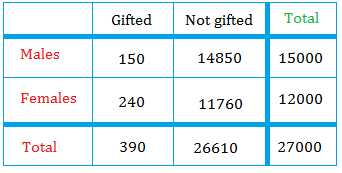Addition rule for probability
Using the addition rule for probability, we will show you how to find the probability of the union of two events.
We will use the table below about students who are gifted and those who are not.

What is the probability that a randomly chosen student is gifted or male?
First, we need to know how many students are gifted or male. Let G = gifted and M = males
The number of students who are gifted or male is the union of G and M written as
G ∪ M
or
G or M
G ∪ M means either gifted, or male, or both.
To find G ∪ M , we need to add the number of gifted students to the number of male students.
Gifted = 150 + 240
Males = 150 + 14850
Gifted + Males = 150 + 240 + 150 + 14850
However, notice that 150 is counted twice. So to avoid double counting, we need to subtract 150 from 150 + 240 + 150 + 14850
150 is the number of students who are gifted and male at the same or G ∩ M
If you don't subtract 150, you will end up counting G ∩ M twice
The number students who are gifted or male is
G ∪ M = 150 + 240 + 150 + 14850 - 150 = 15240.
Let G ∪ M be the probability that a student is gifted or male.

G ∪ M = G + M - G ∩ M
Let us compute for the following probability
P(G ∪ M) = P(G) + P(M) - P(G ∩ M)
P(G ∪ M) = 0.014 + 0.555 - 0.005 = 0.569 - 0.005 = 0.564
In general, here the addition rule for probability.
Let A and B be two events.
Then, P(A or B) = P(A) + P(B) - P(A and B)
Addition rule for probability when the events are mutually exclusive
If A and B are mutually exclusive, it means that A ∩ B= { }
Thus, P(A and B) = 0
P(A or B) = P(A) + P(B)